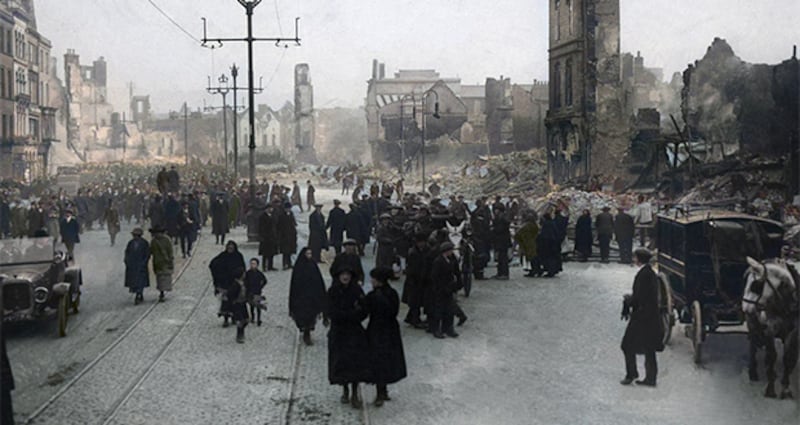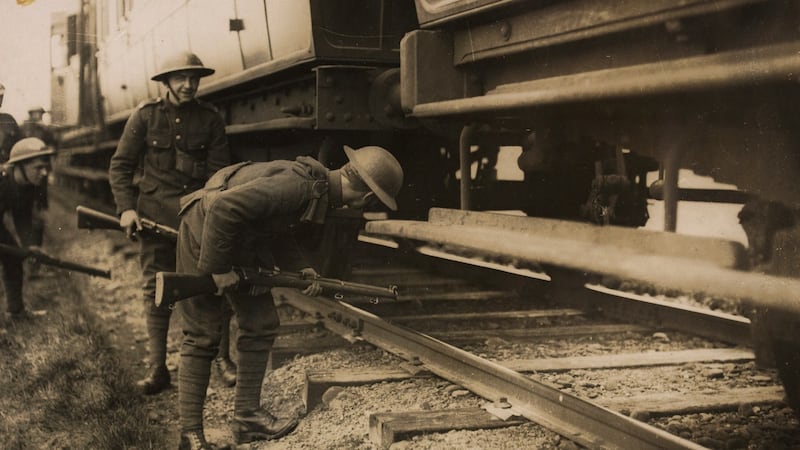The Irish War of Independence was both a political struggle and a military conflict. Militarily, the two sides appeared unfairly matched. By 1921, the British forces fielded roughly 55,000 troops in Ireland, armed with artillery, armoured cars, machine-guns, and airplanes, and supported by the paramilitary Royal Irish Constabulary.
They faced the Irish Republican Army (IRA), a half-trained citizen militia armed with whatever weapons its members could capture. Yet, the republican forces made large parts of the island ungovernable while fighting powerful crown forces to a standstill.
The IRA evolved from the Irish Volunteers organisation established during the Home Rule crisis of 1913-14. At the outset of the first World War, the Irish Volunteers split on the issue of participation in the British war effort.

The vast majority of members followed the pro-war John Redmond and his Irish Parliamentary Party out of the organisation. A small separatist element remained with the Volunteers, and threatened to resist any government attempt to introduce military conscription in Ireland or disarm the Volunteers. That smaller Irish Volunteer organisation numbered about 14,000 by 1916, with much of its strength situated in Dublin.
Following its Easter Rising participation and defeat, the organisation was further weakened by mass arrests and the death and imprisonment of its top leaders. Yet within months of their defeat in Dublin, committed republicans reformed the organisation and prepared for renewed resistance to British governance in Ireland.
Young men in wealthier parts of the country with close economic and cultural links to Britain were less likely to join the IRA
Irish Volunteer networks in Munster led the reorganisation, which was coordinated nationally by Cathal Brugha. The release of the Rising prisoners in late 1916 and mid-1917 further bolstered the restructuring. A leadership group emerged from Frongoch Prison Camp, included Michael Collins and Richard Mulcahy, and began to assert its authority over the organisation in Dublin.
In the provinces, healthy Irish Volunteer units untouched during and after the Rising, provided solid platforms for the Volunteers’ rapid expansion. They recruited members and formed new units, despite government restrictions on drilling and the wearing of uniforms. By late 1917, most towns and villages in the country fielded an Irish Volunteer branch.
A national convention in October 1917 elected a national executive headed by Éamon de Valera, and formed an administrative ‘resident executive’ in Dublin, which was the nucleus of the later General Headquarters staff, known as GHQ.
Built a parish-by-parish organisation
A standardised structure was applied to the Irish Volunteers, which combined British army and Irish nationalist mass movement organising models. Like Daniel O'Connell's Catholic Association and the Irish Land League, the Volunteers built a parish-by-parish organisation.
The smallest unit, called a company, was based in a village, rural parish, or urban neighbourhood. Membership typically numbered between 20 and 150 (in large cities). The next unit level was a battalion, which was comprised of a number of companies (anywhere from three to 10). A battalion was often based in a large town, and took in companies from the surrounding district. Battalion membership figures usually extended from the low hundreds to one or two thousand. A number of battalions comprised a brigade, which was the highest unit formation until spring 1921. Brigade membership typically numbered from one to several thousand.
Overall, taking account for persistent organisational tinkering, the IRA fielded roughly 70 brigades, 300 battalions, and about 2,000 companies by 1921. Its paper strength was 115,000 members, yet only a handful were full-time activists.

The IRA organisation was highly decentralized, with GHQ exercising only nominal control over its provincial brigades. Chief of Staff Richard Mulcahy oversaw 10 departments: adjutant, quartermaster, intelligence, organisation, training, publicity, engineering, purchasing, munitions, and chemicals. Department staff usually numbered fewer than a dozen officers, and typically offered general policy instructions to their opposite numbers in subordinate units.
IRA members swore allegiance to Dáil Éireann, and Richard Mulcahy reported to the Dáil minister for defence Cathal Brugha. By 1921, Brugha’s relationship with Mulcahy and Michael Collins grew tense owing to what he perceived as their lack of deference to civilian control. This was a persistent issue within the IRA, owing to the blurring of military and political roles across the independence movement, with senior IRA officers holding political positions in Sinn Féin, Dáil Éireann, and public bodies.
While Michael Collins’ Intelligence Department was effective in the capital, his importance to the IRA in this period has been exaggerated. Collins’ military influence was felt most keenly in Dublin. He and the rest of GHQ maintained a degree of authority over the Dublin Brigade, recognising the IRA strength in the capital was crucial to republican propaganda and political strategies.
Beyond Dublin, however, GHQ’s reach was limited. IRA Volunteers elected their own unit officers, who usually made decisions collectively. IRA brigades armed themselves, financed themselves, and developed their own operations. This led to an uneven evolution of the IRA across the country. Some brigades were barely functioning by the truce of 1921, while others had built highly efficient guerrilla warfare structures.
Levels of violence
IRA membership was strongest in the western half of the country. Historian David Fitzpatrick has found per capita IRA membership highest in southern and western counties Kerry, Clare, Longford, Sligo, Mayo, and Limerick. Cork, Tipperary, and Kerry experienced the most sustained levels of violence, as measured by fatalities.
The IRA attracted far fewer young men in the province of Ulster, which could be expected in an area with a high Protestant Unionist population. Perhaps more surprising was the poor IRA mobilisation in Leinster, with the noticeable exceptions of Dublin (city) and Longford. Fitzpatrick argues that Connacht and Munster were generally poorer than Leinster and Ulster, but the west and south were also more cosmopolitan and globalised owing to significant emigration rates to the United States, which gave root to republicanism.
Overall, data suggests that young men were less likely to join the IRA in wealthier parts of the country with close economic and cultural links to Britain. In Connacht and Munster, I would also point to high mortality rates during the Great Famine, and more intense rural protest traditions before and after. As a result, British governance may have enjoyed less long-term legitimacy among the population in these areas, which would have strengthened popular support for an armed insurgency in 1920-21.
The IRA attracted young Catholic men of limited social standing. Protestant members were rare, but not entirely absent. In rural areas, IRA Volunteers usually came from small farmer backgrounds rather than the grazier and/or big farm classes; farm labourers were present but under-represented.
In urban areas, the IRA’s backbone was comprised of skilled tradesmen and shop assistants, while those unskilled or semi-skilled labourer members typically enjoyed fulltime positions.
Casual labourers and the unemployed were largely absent, which is not surprising considering the economic cost and risk of IRA membership. High-earning professionals and other members of the middle and upper-middle classes were uncommon.
The most socially privileged IRA officers worked as clerks, teachers, and low-level civil servants. University graduates were few, and probably a strong majority of IRA officers had not finished secondary school. Many officers who lacked extensive formal education had backgrounds in the Gaelic League, which bolstered cultural nationalism while also offering accessible adult education.
IRA survival in the War of Independence was not achieved by flying column riflemen in trench coats or Michael Collins' famed 'Squad', but by ordinary, unarmed Volunteers
Ex-soldiers were rare within the IRA but became more common once guerrilla fighting escalated, with individual ex-servicemen recruited as snipers, training officers, and machine-gunners. Nearly all the IRA leadership lacked formal military training. Ultimately, this probably benefitted an organisation which helped pioneer modern guerrilla warfare. Its strategists developed original tactics that were applicable and distinct to their local geography.
Guerrilla warfare did not derive from a central plan, but developed organically in active units across the country. For example, IRA brigades in Cork, Tipperary, and Limerick, evolved in roughly the same manner despite a lack of coordination between them. Guerrilla warfare was logical to practical leaders who lacked material war-making resources. The most successful units were characterised by ingenuity, adaptability and flexibility in an ever-changing military situation.
Very poorly armed
The IRA remained very poorly armed throughout the War of Independence. GHQ’s failure to adequately import weapons meant most IRA units had to seize their arms from the crown forces or the civilian population. The IRA possessed relatively large numbers of pistols and shotguns, but lacked the firepower of modern rifles.
By 1921, they possessed only about 3,000 rifles (with roughly 50 rounds of ammunition per weapon), meaning republicans were shockingly out-gunned. Full-time fighting units (called ‘flying columns’) were few, and inflicted only minor casualties on the crown forces. Yet, their audaciousness in the face of overwhelming British superiority raised republican morale and helped create the myth of the flying column.
IRA survival in the War of Independence was not achieved by flying column riflemen in trench coats or Michael Collins’ famed ‘Squad’, but by ordinary, unarmed Volunteers. Most Volunteers never fired a gun. Instead they sabotaged roads, watched for raiding crown forces, hid arms, intercepted British communications, scouted for republican fugitives, delivered messages, and carried out other critical, if unglamorous, tasks.
Throughout, the IRA was augmented by the republican women’s organisation Cumann na mBan, especially in the maintenance of their intelligence and communication networks. It was the seemingly menial but essential service that kept the republican insurgency going.
The strength of the IRA lay in its organisation. Throughout the War of Independence the IRA was an effective mass movement, which successfully leveraged the intelligence, ingenuity, and perseverance of its rank-and-file members. Assisted by Cumann na mBan and extensive networks of civilian supporters, these ordinary Volunteers ultimately delivered an extraordinary achievement.









